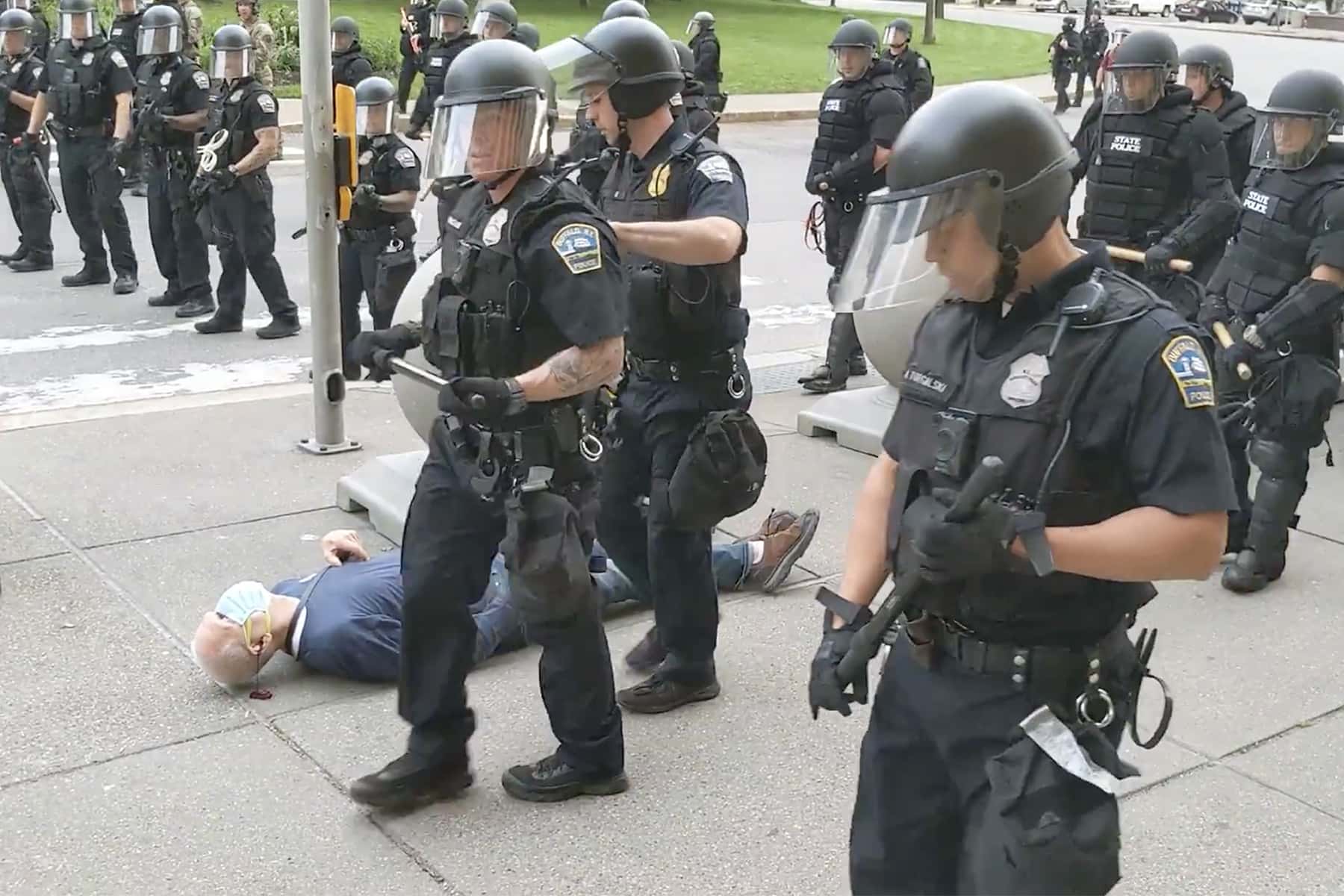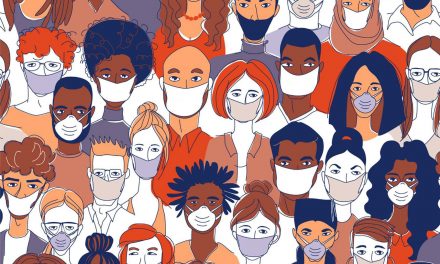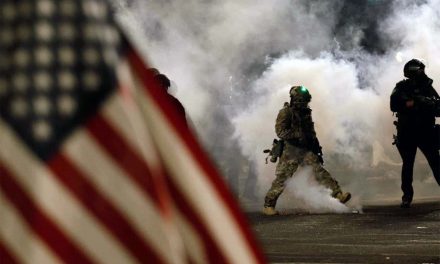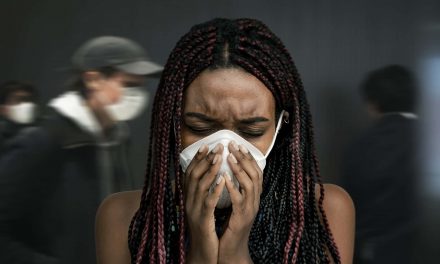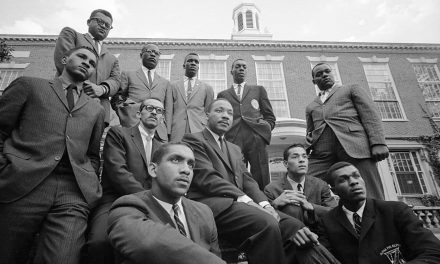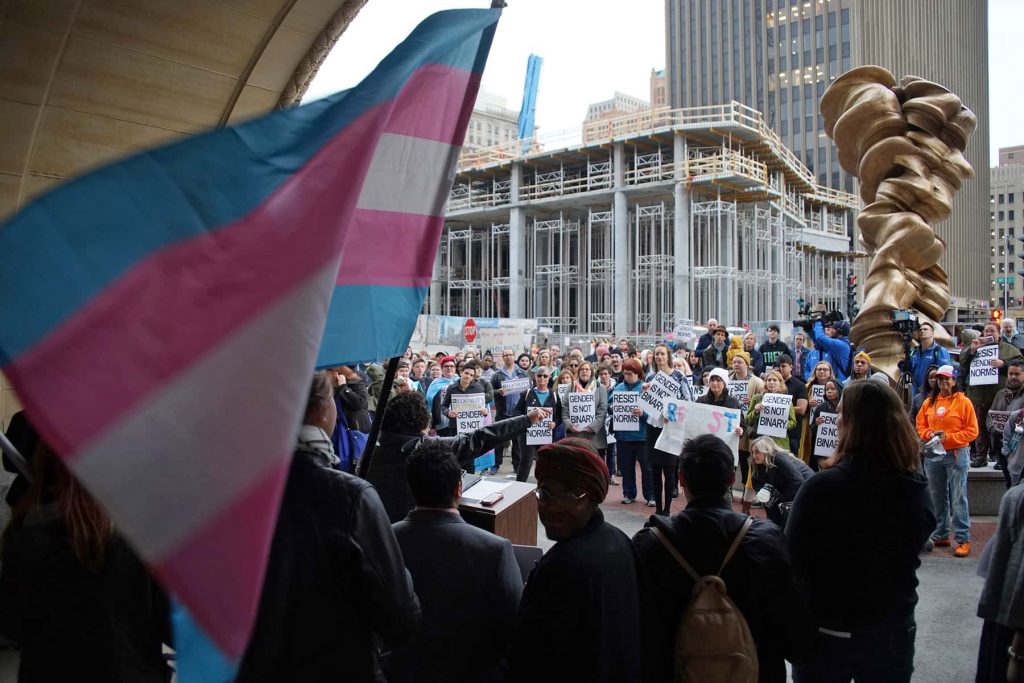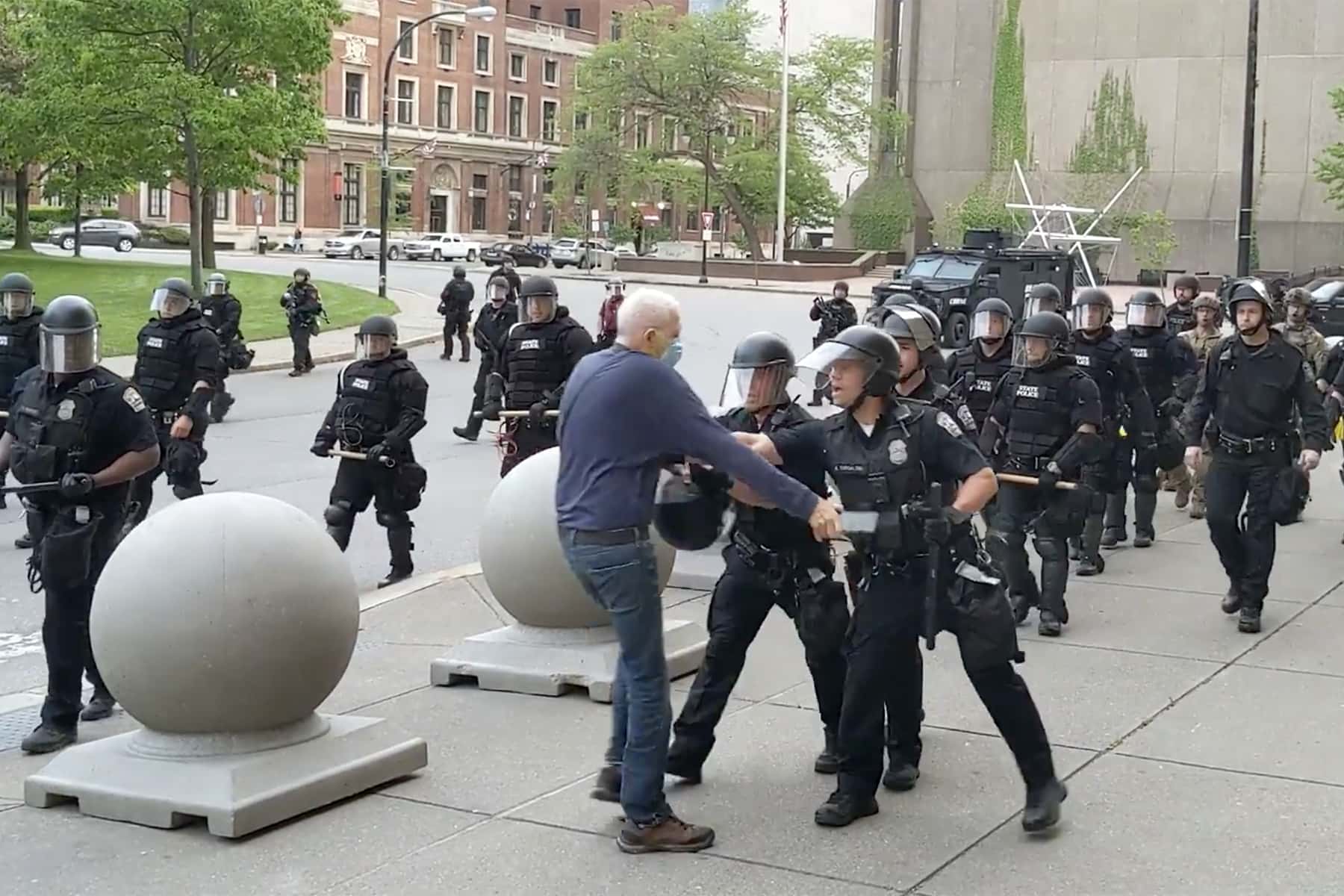
“Yet when something happens in another state, it’s very, very easy to jump on the bandwagon and say Milwaukee can do better. Shame on them. That’s an easy narrative… Two thousand years ago, an angry mob came before people to say ‘Crucify that man.’ That man being Jesus Christ. What are angry mobs doing today? We say we’re civilized, but are we really? Just think about that… And that includes you, media. You can play a big role in changing the perceptions that are out there.” – Alfonso Morales, Milwaukee Police Chief
“Our position is these officers were simply following orders from Deputy Police Commissioner Joseph Gramaglia to clear the square. It doesn’t specify clear the square of men, 50 and under or 15 to 40. They were simply doing their job. I don’t know how much contact was made. He did slip in my estimation. He fell backwards.” – John Evans, president of the Buffalo Police Benevolent Association
These are signs of the times. Milwaukee’s Police Chief has compared criticism of his officers to the crucifixion of Jesus and the police union in Buffalo, New York defended two officers who shoved a 75-year-old man to the ground causing him to bleed from his head and ear. Police and firefighters gathered outside a Buffalo, New York courthouse applauding Officers Aaron Torgalski and Robert McCabe as they left their arraignment. Many wore shirts showing support, including phrases like “We back the blue.”
There are clear signs to me that the changes people are expecting to see with police reforms will not be forthcoming in the way many expect. The main problem with policing is within the mindset of policing and mostly white Americans consistent support for them even when they commit criminal acts particularly against black citizens. They appear to be constantly on the defensive and rarely ever admit wrongdoing.
The sentiment of “backing the blue” is built into the basic fabric of policing around the country. They receive such widespread support from the white public consistently when chants of “Black Lives Matter” are met with chants of “Blue Lives Matter.” Changing the institutional frame of mind within police departments is akin to turning around a battleship. It will be exceptionally difficult to do and despite the current shows of support by many in the white community now, when the clouds of teargas die off and the protests end we will see just how hard this challenge really is.
“The proof is in the pudding.” – American idiom.
After two members of Buffalo’s Emergency Response Team (ERT) were caught in a viral video shoving Martin Gugino to the ground where he sustained injuries to his head requiring hospitalization, two of the officers involved were suspended, all 57 members of the ERT resigned from the unit to support their fellow officers.
I lived in the Los Angeles area when LAPD officers beat Rodney King. I witnessed the acquittal of the officers involved and subsequent unrest that followed. On March 3, 1991 two California Highway Patrol officers pursued a speeding Hyundai driven by Rodney King in Los Angeles. By the time the pursuit ended, nearly a dozen LAPD units, 23 officers, a police helicopter, two highway patrol officers and several members of the Los Angeles Unified School District police were on the scene.
A nearby resident, George Holliday, filmed a short part of the beating. On March 4, Holliday took his film to Los Angeles television station KTLA and they showed the footage that night. It was shown on CNN the following day. In just over two minutes, Holliday’s video camera captured 56 baton blows, and six kicks applied by the officers. The beating lasted around fifteen minutes. King suffered a broken cheekbone, a broken ankle, a skull fracture, a broken orbital bone in one eye, broken teeth, and brain damage, as well as multiple lacerations requiring 20 stitches.
The police reports written after the encounter by officers claimed the injuries were only superficial abrasions and contusions. Los Angeles Mayor Tom Bradley and Police Chief Daryl Gates immediately condemned the actions of the officers. Gates said he expected felony charges to be filed but called the beating “an aberration.”
In only two weeks the Los Angeles Times wrote fifty-five articles about the beating. There were twenty-one stories in the New York Times, and fifteen in the Chicago Tribune over the same time period. ABC News produced eight stories about the beating.
Witnesses to the beating described officers as “laughing and chuckling like they had just had a party.” King was brought to a news conference in a wheelchair and said, “I’m lucky they didn’t kill me.”
As a result of the community outrage over the beating the “official investigations” began. What was unique in this case, was that there were literally four “official investigations.” The grand jury investigated, the FBI investigated, Chief Gates’ Arguelles Commission investigated and Mayor Bradley’s Christopher Commission investigated.
The combined reports of the Arguellesand Christopher Commissions found “a systemic failure to control officers with repeated complaints of excessive force, discovered significant racism and bias within the department; and found tactics of intimidation designed to discourage public citizens trying to make complaints.” Gates was forced to resign.
The police officers, Laurence Powell, Timothy Wind, Theodore Briseno and Stacey Koon were eventually charged with using excessive force. Immediately after the beating, Koon typed a message into his in-car computer: “U just had a big time use of force. Tased and beat the suspect of CHP pursuit.” Powell typed, “I haven’t beaten anyone this bad in a long time.” We discovered later that he had described the scene of a domestic disturbance involving African-Americans as right out of “Gorillas in the Mist.”
“I felt beat up and like a crushed can. That’s what I felt like, like a crushed can all over, and my spirits were down real low.” – Rodney King testimony to the grand jury
The trial was eventually moved to Simi Valley, California, a community known as a place where firefighters and police officers retire. The jury pool of 260 people included only a half dozen blacks, five of which stated they had no desire to serve on a jury in hostile territory. Two of the eventual jurors were N.R.A. members and two others were retired military veterans.
During the trial, emergency room nurse Lawrence Davis testified that Powell compared the beating to “a good hardball game,” and boasted that he had hit “quite a few home runs.” Expert witness for the defense, Sergeant Charles Duke on the other hand, testified that it was sometimes necessary “to break a bone” and that every one of the fifty-six baton swings shown on the videotape was justified.
Despite what many assumed was overwhelming video evidence, the jury deliberated for seven days, and acquitted the officers on April 29, 1992, triggering six days of unrest that resulted in 63 people being killed, more than 2,300 injuries, 12,000 arrests and about $1 billion in property damage. More than 3,600 fires were set and 1,100 buildings were destroyed.
There were similar responses after police killed unarmed Michael Brown in Ferguson, Missouri in 2014, after Freddie Gray died in police custody in Baltimore in 2016 and Sylville Smith was shot to death by a police officer in Milwaukee later the same year. Investigations, commissions and promises of reform were heard after each incident.
There have been dozens of investigations of police departments around the country by the US Department of Justice (DOJ). The findings are strikingly similar whether you look at Chicago, Baltimore, Seattle, Miami, Milwaukee, Ferguson, Cleveland, Portland, New Orleans or Detroit. Most are littered with evidence of excessive use of force particularly against blacks, and large disproportionality in traffic and pedestrian stops.
In November 2015 Milwaukee Police Chief Edward Flynn requested DOJ assistance in assessing the MPD and helping to put it “on a path toward an ‘evolution of reform’” according to the draft document which was leaked to the Milwaukee Journal Sentinel because release of the full report was stopped by the DOJ under President Trump.
The findings were quite disturbing. When looking at use of force by the department they found, “MPD has no formal training for their IAD investigators and does not have specific guidelines for conducting use of force investigations…” It also found “MPD command does not routinely review the involved officer(s)’ use of force, complaint discipline history in sustained use of force investigations.”
Other findings include “MPD’s traffic enforcement practices have a disparate impact on the African-American community—with disparity across all police districts but even more so in districts with predominately White populations. Exacerbating this is the fact that MPD lacks the proper oversight and accountability for pedestrian stops.”
They stated that the “MPD does not have a written directive that states ‘the ability to testify in court with credibility’ is an essential job function of the police officer job description.” I have been told by multiple sources that the District Attorney’s office has a list of officers who are not allowed to testify in court because they perjured themselves in the past.
These are key elements of the distrust the black community has with MPD. Some important cases led to the DOJ being in town in the first place. According to the report they included:
- Dontre Hamilton, an African American man was shot 14 times after a struggle with an officer, despite an earlier determination by another police unit that he was not engaged in criminal conduct.
- Deron Love, an arrestee who was handcuffed to a wall in an interview room, was assaulted by an officer. The event was captured on interview room video.
- Derek Williams, a suspect, complained of breathing difficulty, but was not provided timely medical attention following a foot chase. Fifteen minutes after the arrest, he died.
- Concerns over allegations of illegal strip and cavity searches were presented in a lawsuit involving more than 60 victims. One of the officers implicated had a prior conviction for sexual assault, raising concerns over hiring practices and proper supervision in that the plaintiff alleged that he had made prior complaints and been ignored. The officer subsequently pled guilty to four felony and four misdemeanor charges.
Looking specifically at use of force, the report found “11 officers were identified as significant statistical outliers, having used force 21 or more times from 2011 to 2015. Overall African Americans are disproportionately impacted by MPD use of force. While comprising approximately 39 percent of the Milwaukee population, they comprise 75 percent of all use of force subjects…”
When looking at traffic stop data they found “the Department’s primary law enforcement strategy is to stop as many vehicles as possible in high crime areas…” When interviewing officers they were told “many officers stated they were never told of the rationale behind the focus on traffic stops, they did not believe that the traffic stop strategy would reduce crime, and they feel pressured to conduct traffic stops… many officers indicated they felt they had a quota of two traffic stops per shift. If they did not achieve those numbers, they believed there would be some type of retribution.”
While conducting listening sessions with members of the African American community they heard “from teenagers and young adults that they are sometimes afraid of walking in their communities, not because of the danger of crime, but in fear of being stopped by police.” Even outside of their neighborhoods there was a significant chance of being pulled over. In District One African Americans were 8.4 percent of residents but 66 percent of traffic stops, In District Two 7.9 percent of residents and 63 percent of stops, in District Six 3.1 percent of residents and 64 percent of traffic stops. In the 146,474 pedestrian stops from 2013-2015 African Americans were stopped at twice the rate of whites and only 4.64 percent of all pedestrian stops ended with an arrest and blacks represented 84.1 percent of all citizens searched.
So as we look at the protests occurring around the country it is imperative that we clearly understand that these policing issues are systemic and not the product of “a few bad apples” or simply related to black people being killed by police.
“They consider themselves different humans than we are. They are a family, a big family.” – Rodney King, describing the officers who beat him in 1991
Data from city after city show the same outcomes. Despite expectations after police involved killings like Amadou Diallo, Sean Bell, and Eric Garner in New York things did not really change as much as people hoped. Baltimore had unrest and marches after Freddie Gray died in police custody but no one was ultimately held responsible.
Michael Brown’s death led to unrest and marches around the country but here we are six years later watching another black man die unnecessarily. No one was found responsible in court for the killing of 12-year-old Tamir Rice in Cleveland in 2014.
We still say the names of black women killed by police: Michelle Cusseaux, Miriam Carey, Tanisha Anderson, Shantel Bumpers, Rekia Boyd, Megan Hockaday, Natasha McKenna, Shelly Frey, Kayla Moore, Alberta Spruil, Kyam Livingston to name a few.
It is time to recognize that the same confidence people felt in 1963 after the March on Washington and in 1964 after the Passage of the Civil Rights Act, the 1965 Voting Rights Act, the 1968 Fair Housing Act and 2008 election of Barack Obama can be instrumental in tempering our expectations of real significant institutional change in America.
Policing in America has not changed much in the face of protests in the past. It may appear different this time because of how widespread the protests are and the numbers of whites seemingly in support, but I caution Americans to not get too excited until they see evidence of real change which will include testimony from African Americans that their daily lived experiences with police are better.
As soon as we see another unarmed black killed by police, and believe me we will, it will be evidence that words don’t always match deeds.
“Is it a reckoning or just another dance?” – Howard Bryant, ESPN senior columnist
“You’re going to come across people in your life who will say all the right words at all the right times. But in the end, it’s always their actions you should judge them by. It’s actions, not words that matter.” – Nicholas Sparks
© Photo
Kristine Porter via Twitter

